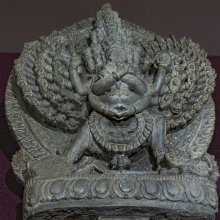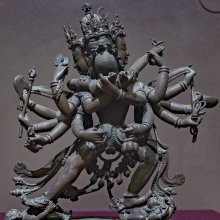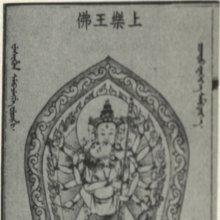Cakrasamvara, Cakrasaṃvara: 6 definitions
Introduction:
Cakrasamvara means something in Buddhism, Pali, Hinduism, Sanskrit. If you want to know the exact meaning, history, etymology or English translation of this term then check out the descriptions on this page. Add your comment or reference to a book if you want to contribute to this summary article.
Cakrasamvara has 4 English definitions available.
Alternative spellings of this word include Chakrasamvara.
Images (photo gallery)
(+11 more images available)
Languages of India and abroad
Sanskrit dictionary
[Deutsch Wörterbuch]
Source: Cologne Digital Sanskrit Dictionaries: Böhtlingk and Roth Grosses Petersburger WörterbuchCakrasaṃvara (चक्रसंवर):—(cakra + saṃvara) m. Nomen proprium eines Buddha (auch vajraṭīka u. s. w.) [Trikāṇḍaśeṣa 1, 1, 23.]
Source: Cologne Digital Sanskrit Dictionaries: Sanskrit-Wörterbuch in kürzerer FassungCakrasaṃvara (चक्रसंवर):—m. Nomen proprium eines Buddha.
Sanskrit, also spelled संस्कृतम् (saṃskṛtam), is an ancient language of India commonly seen as the grandmother of the Indo-European language family (even English!). Closely allied with Prakrit and Pali, Sanskrit is more exhaustive in both grammar and terms and has the most extensive collection of literature in the world, greatly surpassing its sister-languages Greek and Latin.
See also (Relevant definitions)
Partial matches: Cakra, Samvara.
Starts with: Cakrasamvaranayika, Cakrasamvarasamadhi, Cakrasamvaratantra, Cakrasamvaratantravritti.
Full-text (+1898): Guhyavajrini, Pushpadhishthana, Sahasrabhuja, Vajradhatvishvari, Jvalanalarka, Sharajala, Mantrapatradhishthana, Mantrakarotaka, Mahakalpagni, Dhumrandhakara, Damshtrakarala, Shankhadhishthana, Vitana, Dhumra, Prakara, Vajraprakara, Kalanka, Utkata, Vajrakilaya, Agnisamnibha.
Relevant text
Search found 4 books and stories containing Cakrasamvara, Cakrasaṃvara, Cakra-samvara, Cakra-saṃvara; (plurals include: Cakrasamvaras, Cakrasaṃvaras, samvaras, saṃvaras). You can also click to the full overview containing English textual excerpts. Below are direct links for the most relevant articles:
Blue Annals (deb-ther sngon-po) (by George N. Roerich)
Chapter 1c - The Zur Geneology (xii): Jo bsod of dbus < [Book 3 - Early translations of Secret Mantra]
Chapter 5 - Cakrasaṃvara < [Book 7 - The preaching of the Tantras]
Chapter 6 - First incarnation series (iii): spom brag pa < [Book 8 - The famous Dakpo Kagyü (traditions)]
Guhyagarbha Tantra (with Commentary) (by Gyurme Dorje)
Commentary (the maṇḍala of contemplation)—Introduction < [Chapter 6 (text and commentary)]
Text 5.8 (Commentary) < [Chapter 5 (text and commentary)]
Text 9.4 (Commentary) < [Chapter 9 (Text And Commentary)]
The Indian Buddhist Iconography (by Benoytosh Bhattachacharyya)
Bodhisattvacharyavatara (by Andreas Kretschmar)
Text Sections 130-131 < [Khenpo Chöga’s Oral Explanations]
Related products





